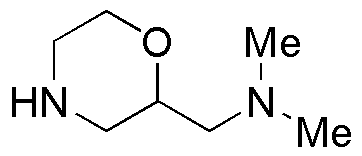Dimethyl-morpholin-2-ylmethylamine is widely utilized in research focused on:
- Pharmaceutical Development: This compound serves as a building block in the synthesis of various pharmaceuticals, particularly in creating drugs that target neurological disorders.
- Agricultural Chemicals: It is employed in the formulation of agrochemicals, enhancing the efficacy of pesticides and herbicides by improving their absorption in plants.
- Polymer Chemistry: Used as a curing agent in epoxy resins, it contributes to the production of durable and heat-resistant materials, which are essential in construction and automotive industries.
- Analytical Chemistry: This chemical acts as a reagent in various analytical techniques, aiding in the detection and quantification of specific compounds in complex mixtures.
- Cosmetic Formulations: Its properties make it suitable for use in personal care products, where it helps to stabilize formulations and enhance skin absorption.
General Information
Properties
Safety and Regulations
Applications
Dimethyl-morpholin-2-ylmethylamine is widely utilized in research focused on:
- Pharmaceutical Development: This compound serves as a building block in the synthesis of various pharmaceuticals, particularly in creating drugs that target neurological disorders.
- Agricultural Chemicals: It is employed in the formulation of agrochemicals, enhancing the efficacy of pesticides and herbicides by improving their absorption in plants.
- Polymer Chemistry: Used as a curing agent in epoxy resins, it contributes to the production of durable and heat-resistant materials, which are essential in construction and automotive industries.
- Analytical Chemistry: This chemical acts as a reagent in various analytical techniques, aiding in the detection and quantification of specific compounds in complex mixtures.
- Cosmetic Formulations: Its properties make it suitable for use in personal care products, where it helps to stabilize formulations and enhance skin absorption.
Documents
Safety Data Sheets (SDS)
The SDS provides comprehensive safety information on handling, storage, and disposal of the product.
Product Specification (PS)
The PS provides a comprehensive breakdown of the product’s properties, including chemical composition, physical state, purity, and storage requirements. It also details acceptable quality ranges and the product's intended applications.
Certificates of Analysis (COA)
Search for Certificates of Analysis (COA) by entering the products Lot Number. Lot and Batch Numbers can be found on a product’s label following the words ‘Lot’ or ‘Batch’.
*Catalog Number
*Lot Number
Certificates Of Origin (COO)
This COO confirms the country where the product was manufactured, and also details the materials and components used in it and whether it is derived from natural, synthetic, or other specific sources. This certificate may be required for customs, trade, and regulatory compliance.
*Catalog Number
*Lot Number
Safety Data Sheets (SDS)
The SDS provides comprehensive safety information on handling, storage, and disposal of the product.
DownloadProduct Specification (PS)
The PS provides a comprehensive breakdown of the product’s properties, including chemical composition, physical state, purity, and storage requirements. It also details acceptable quality ranges and the product's intended applications.
DownloadCertificates of Analysis (COA)
Search for Certificates of Analysis (COA) by entering the products Lot Number. Lot and Batch Numbers can be found on a product’s label following the words ‘Lot’ or ‘Batch’.
*Catalog Number
*Lot Number
Certificates Of Origin (COO)
This COO confirms the country where the product was manufactured, and also details the materials and components used in it and whether it is derived from natural, synthetic, or other specific sources. This certificate may be required for customs, trade, and regulatory compliance.

